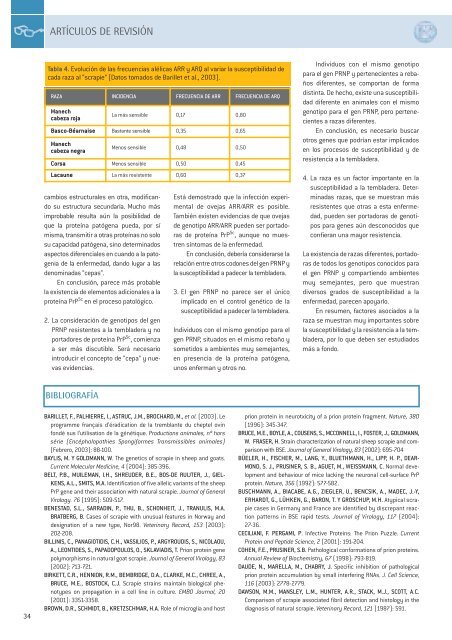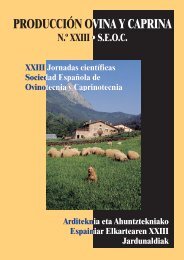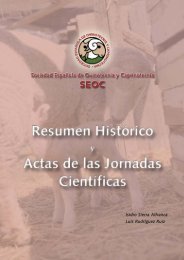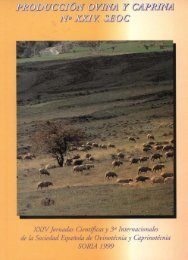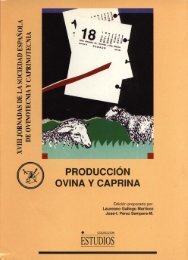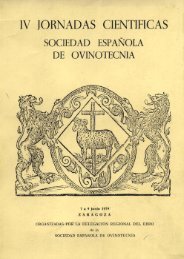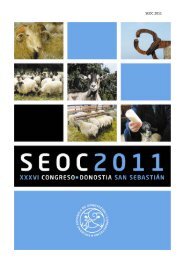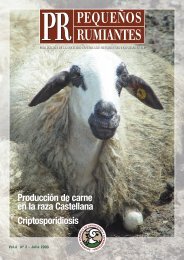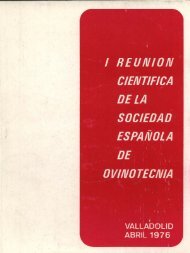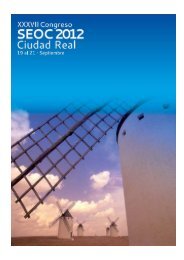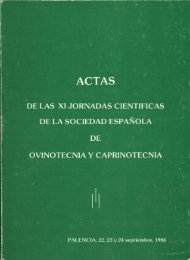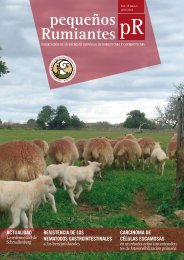ARTÍCULOS DE REVISIÓNTabla 4. Evolución de las frecuencias alélicas ARR y ARQ al variar la susceptibilidad decada raza al “scrapie” (Datos tomados de Barillet et al., 2003).RAZA INCIDENCIA FRECUENCIA DE ARR FRECUENCIA DE ARQManechcabeza rojacambios estructurales en otra, modificandosu estructura secundaria. Mucho másimprobable resulta aún la posibilidad deque la proteína patógena pueda, por símisma, transmitir a otras proteínas no solosu capacidad patógena, sino determinadosaspectos diferenciales en cuando a la patogeniade la enfermedad, dando lugar a lasdenominadas “cepas”.En conclusión, parece más probablela existencia de elementos adicionales a laproteína PrP Sc en el proceso patológico.2. La consideración de genotipos del genPRNP resistentes a la tembladera y noportadores de proteína PrP Sc , comienzaa ser más discutible. Será necesariointroducir el concepto de “cepa” y nuevasevidencias.La más sensible 0,17 0,80Basco-Béarnaise Bastante sensible 0,35 0,65Manechcabeza negraMenos sensible 0,48 0,50Corsa Menos sensible 0,50 0,45Lacaune La más resistente 0,60 0,37Está demostrado que la infección experimentalde ovejas ARR/ARR es posible.También existen evidencias de que ovejasde genotipo ARR/ARR pueden ser portadorasde proteína PrP Sc , aunque no muestrensíntomas de la enfermedad.En conclusión, debería considerarse larelación entre otros codones del gen PRNP yla susceptibilidad a padecer la tembladera.3. El gen PRNP no parece ser el únicoimplicado en el control genético de lasusceptibilidad a padecer la tembladera.Individuos con el mismo genotipo para elgen PRNP, situados en el mismo rebaño ysometidos a ambientes muy semejantes,en presencia de la proteína patógena,unos enferman y otros no.Individuos con el mismo genotipopara el gen PRNP y pertenecientes a rebañosdiferentes, se comportan de formadistinta. De hecho, existe una susceptibilidaddiferente en animales con el mismogenotipo para el gen PRNP, pero pertenecientesa razas diferentes.En conclusión, es necesario buscarotros genes que podrían estar implicadosen los procesos de susceptibilidad y deresistencia a la tembladera.4. La raza es un factor importante en lasusceptibilidad a la tembladera. Determinadasrazas, que se muestran másresistentes que otras a esta enfermedad,pueden ser portadoras de genotipospara genes aún desconocidos queconfieran una mayor resistencia.La existencia de razas diferentes, portadorasde todos los genotipos conocidos parael gen PRNP y compartiendo ambientesmuy semejantes, pero que muestrandiversos grados de susceptibilidad a laenfermedad, parecen apoyarlo.En resumen, factores asociados a laraza se muestran muy importantes sobrela susceptibilidad y la resistencia a la tembladera,por lo que deben ser estudiadosmás a fondo.BIBLIOGRAFÍA34BARILLET, F., PALHIERRE, I., ASTRUC, J.M., BROCHARD, M., et al. (2003). Leprogramme français d’éradication de la tremblante du cheptel ovinfondé sus l’utilisation de la génétique. Productions animales, nº horssérie (Encéphalopathies Spongiformes Transmissibles animales)(Febrero, 2003): 88-100.BAYLIS, M. Y GOLDMANN, W. The genetics of scrapie in sheep and goats.Current Molecular Medicine, 4 (2004): 385-396.BELT, P.B., MUILEMAN, I.H., SHREUDER, B.E., BOS-DE RUIJTER, J., GIEL-KENS, A.L., SMITS, M.A. Identification of five allelic variants of the sheepPrP gene and their association with natural scrapie. Journal of GeneralVirology. 76 (1995): 509-517.BENESTAD, S.L., SARRADIN, P., THU, B., SCHONHEIT, J., TRANULIS, M.A.BRATBERG, B. Cases of scrapie with unusual features in Norway anddesignation of a new type, Nor98. Veterinary Record, 153 (2003):202-208.BILLINIS, C., PANAGIOTIDIS, C.H., VASSILIOS, P., ARGYROUDIS, S., NICOLAOU,A., LEONTIDES, S., PAPADOPOULOS, O., SKLAVIADIS, T. Prion protein genepolymorphisms in natural goat scrapie. Journal of General Virology, 83(2002): 713-721.BIRKETT, C.R., HENNION, R.M., BEMBRIDGE, D.A., CLARKE, M.C., CHREE, A.,BRUCE, M.E., BOSTOCK, C.J. Scrapie strains maintain biological phenotypeson propagation in a cell line in culture. EMBO Journal, 20(2001): 3351-3358.BROWN, D.R., SCHMIDT, B., KRETZSCHMAR, H.A. Role of microglia and hostprion protein in neurotxicity of a prion protein fragment. Nature, 380(1996): 345-347.BRUCE, M.E., BOYLE, A., COUSENS, S., MCCONNELL, I., FOSTER, J., GOLDMANN,W. FRASER, H. Strain characterization of natural sheep scrapie and comparisonwith BSE. Journal of General Virology, 83 (2002): 695-704BÜELER, H., FISCHER, M., LANG, Y., BLUETHMANN, H., LIPP, H. P., DEAR-MOND, S. J., PRUSINER, S. B., AGUET, M., WEISSMANN, C. Normal developmentand behaviour of mice lacking the neuronal cell-surface PrPprotein. Nature, 356 (1992): 577-582.BUSCHMANN, A., BIACABE, A.G., ZIEGLER, U., BENCSIK, A., MADEC, J.-Y,ERHARDT, G., LÜHKEN, G., BARON, T. Y GROSCHUP, M.H. Atypical scrapiecases in Germany and France are identified by discrepant reactionpatterns in BSE rapid tests. Journal of Virology, 117 (2004):27-36.CECILIANI, F. PERGAMI, P. Infective Proteins: The Prion Puzzle. CurrentProtein and Peptide Science, 2 (2001): 191-204.COHEN, F.E., PRUSINER, S.B. Pathological conformations of prion proteins.Annual Review of Biochemistry, 67 (1998): 793-819.DAUDE, N., MARELLA, M., CHABRY, J. Specific inhibition of pathologicalprion protein accumulation by small interfering RNAs. J. Cell Science,116 (2003): 2778-2779.DAWSON, M.M., MANSLEY, L.M., HUNTER, A.R., STACK, M.J., SCOTT, A.C.Comparison of scrapie associated fibril detection and histology in thediagnosis of natural scrapie. Veterinary Record, 121 (1987): 591.
ARTÍCULOS DE REVISIÓNDEFRA. http://www.defra.gov.uk/news/2004/041207b.htmDICKINSON, A.G. TAYLOR, D.M. Resistance of scrapie agent to decontamination.New England Journal of Medicine, 299 (1978): 1413-1414.ELSEN, J.M., AMIGUES, Y., SCHELCHER, F., DUCROCQ, V., ANDREOLETTI, O.,EYCHENNE, F., KHANG, J.V., POIVEY, J.P., LANTIER, F., LAPLANCHE, J.L.Genetic susceptibility and transmission factors in scrapie: detailedanalysis of an epidemic in a closed flock of Romanov. Archives ofVirology, 144(3) (1999): 431-45.GOLDMANN, W. PrP gene and its association with spongiform encephalopathies.British Medical Bulletin, 49 (1993): 839-859.GOLDMANN, W., MARTIN, T., FOSTER, J., HUGHES, S., SMITH, G., HUGHES, K.,DAWSON, M., HUNTER, N. “Novel polymorphisms in the caprine PrPgene: a codon 142 mutation associated with scrapie incubationperiod”. Journal of General Virology 77 (1996):2885-2891.GOLDMANN, W., CHONG, A., FOSTER, J., HOPE, J., HUNTER, N. “The shortestknown prion protein gene allele occurs in goats has only 3 octapeptiderepeats and is non-pathogenic”. Journal of General Virology 79(1998):3173-3176.GOVAERTS, C., WILLE, H., PRUSINER, S.B., COHEN, F.E. Evidence forassembly of prions with left-handed beta-helices into trimers.Proceedings of the National Academy of Sciences of the U S A, 101(2004):8342-7.HERNANDEZ-SANCHEZ, J., WADDINGTON, D., WIENER, P., HALEY, C.S.WILLIAMS, J.L. Genome-wide search for markers associated with bovinespongiform encepfalopathy. Mammalian Genome, 13 (2002): 164-168.HOPE, J., MULTHAUP, G., REEKIE, L.J., KIMBERLIN, R.H., BEYREUTHER, K.Molecular pathology of scrapie-assocíated fibril protein (PrP) in mousebrain affected by the ME7 strain os scrapie. European Journal ofBiochemistry, 172 (1998):271-277.HSIAO, K., BAKER, H.F., CROW, T.J., POULTER, M., OWEN, F., TERWILLIGER,J.D., WESTAWAY, D., OTT, J. PRUSINER, S.B. Linkage of a prion proteinmissense variant to Gerstmann-Straussler syndrome. Nature, 338(1989): 342-345.HUNTER, N. Molecular biology and Genetics of scrapie in sheep (en thegenetics of sheep, editores L. Piper y A. Ruvinsky, Editorial CabInternational) Capítulo 9 (1997): 225-239.HUNTER, N., GOLDMANN, W., SMITH, G., HOPE, J. “Frequencies of PrP genevariants in healthy cattle and cattle with BSE in Scotland” VeterinaryRecord, 135 (1994): 400-403.JULING, K., WIEDEMANN, S., BELLAGAMBA, F., LICHTNER, P., BETTECKEN, T.,MEITINGER, T., WILLIAMS, J. FRIES, R. HEXA – A locus affecting BSE incattle?. Proceedings of the 29 th International Conference on AnimalGenetics. Tokyo, Japón (2004).KASCSAK, R.J., RUBENSTEIN, R., MERZ, P.A., CARP, R.I., ROBAKIS, N.K., WIS-NIEWSKI, H.M. DIRINGER, H. Immunological comparison of scrapieassociatedfibrils isolated from animals infected with four differentscrapie strains. Journal of Virology, 59 (1986): 676-683KUCZIUS, T. GROSCHUP, M.H. Differences in proteinase K resistance andneuronal deposition of abnormal prion proteins characterize bovinespongiform encephalopathy (BSE) and scrapie strains. MolecularMedicine, 5 (1999): 406-418.LASMÉZAS, C.I., DESLYS, J.P., ROBAIN, O., JAEGLY, A., BERINGUE, V., PERYN,J.M., FOURNIER, J.G., HAUW, J.J., ROSSIER, J., DORMONT, D. Transmissionof the BSE agent to mice in the absence of detectable abnormal prionprotein. Science, 275 (1997): 402-405.LLOYD, S.E., ONWUAZOR, O.N., BECK, J.A., MALLINSON, G., FARRALL, M., TAR-GONSKI, P., COLLINGE, J. FISHER, E.M. Identification of multiple quantitativetrait loci linked to prion disease incubation period in mice.Proceedings of the National Academy of Sciences of the USA, 98(2001): 6279-6283.MANOLAKOU, K., BEATON, J., MCCONNELL, I., FARQUAR, C.,.MANSON, J. HAS-TIE, N.D., BRUCE, M. JACKSON, I.J. Genetic and environmental factorsmodify bovine spongiform encephalopathy incubation period in mice.Proceedings of the National Academy of Sciences of the USA, 98(2001): 7402-7407.MANSON, J.C., CLARKE, A.R., MCBRIDE, P.A., MCCONNELL, I., HOPE, J. PrPgene dosage determines the timing but not the final intensity or distributionof lesions in scrapie pathology. Neurodegeneration. 3 (1994):331-340.MEDORI, R., TRTSCHLER, H.J., LEBLANC, A. Fatal familial insomnia, a priondisease with a mutation at codon 178 of the prion protein gene. N. Engl.J. Med. 326 (1992): 444-449.MERZ, P.A., SOMERVILLE, R.A., WISNIEWSKI, H.M., IQBAL, K. Abnormalfibrils from scrapie-infected brain. Acta Neuropathologica (Berlin) 54(1981): 63-74.MOORE, R.C., HOPE, J., MCBRIDE, P.A., MCCONELL, I., SELFRIDGE, J., MEL-TON, D.W. MANSON, J.C. Mice with gene targeted prion protein alterationsshow that Prnp, Sinc and Prni are congruent. Nature Genetics, 18(1998): 118-125MORENO, C.R., LANTIER, I., LANTIER, F., ANDREOLETTI, O., VAIMAN, D.,SARRADIN, P., ECHEYNNE, F., CRIBIU, E.P., COSSEDDU, G. ELSEN, F.M.Transposition to sheep of mouse quantitative trait loci (QTL) influencingsusceptibility to prion diseases. 7th World Congress on GeneticsApplied to Livestock Production (2002): 687-690.MORENO, C.R., COSSEDDU, G., ANDREOLETTI, O., SCHINDLER, L., ROIG, A.,MOZAMI-GOUDARZI, K., ECHEYNNE, F., LAJOUS, D., SCHERCHER, F., CRI-BIU, E.P., VAIMAN, D., ELSEN, F.M. Identification of quantitative trait loci(QTL) modulating prion incubation period in sheep. Proceedings of theInternational Workshop on Major genes and QTL in Sheep and Goat.Toulouse, Francia (2003).MOUM, I., HOPP, P., MOLDAL, T., VALHEIM, M., MOUM, T. BENESTAD,SL.Polymorphisms at codons 141 and 154 in the ovine prion protein geneare associated with scrapie Nor98 cases. Journal of General Virology,86 (2005): 231-235.NEIBERGS, H.L., RYAN, A.M., WOMACK, J.E., SPOONER, R.L. WILLIAMS, J.L.Polymorphism analysis of the prion gene in BSE-affected and unaffectedcattle. Animal Genetics, 25 (1994): 313-317.OESCH, B., WESTAWAY, D., WALCHLI, M., MCKINLEY, M.P., KENT, S.B.,AEVERSOLD, R., BARRY, R.A., TEMPST, P., TEPLOW, D.B., HOOD, L.E. “A cellulargene encodes scrapie PrP 27-30 protein”. Cell, 40 (1985): 735-746.ORGE, L., GALO, A., MACHADO, C., LIMA, C., OCHOA, C., SILVA, J., RAMOS, M.PEDRO SIMAS, J. Identification of putative atypical scrapie in sheep inPortugal. Journal of General Virology, 85 (2004): 3487-3491PRUSINER, S.B. Novel proteinaceous infectious particles cause scrapie.Science, 216 (1982): 136-144.REZAEI, H., MARC, D., CHOISET, Y., TAKAHASHI, M., HUI BON HOAM G.,HAERTLE, T., GROSCLAUDE, J., DEBEY, P. High yield purification andphysico-chemical properties of full-length recombinant allelic variantsof sheep prion protein linked to scrapie susceptibility. EuropeanJournal of Biochemistry, 267 (2000): 2833-2839SCOTT, A.C., STACK, M.J., DONE, S.H., SAWSON, M. Scrapie assocíated fibrildetection on descomposed and fixed ovine brain materíal. Research inVeterinary Science, 55 (1993): 173-178.SETTANNI, G., HOANG, T.X., MICHELETTI, C., MARITAN, A. Folding pathwaysof prion and doppel. Biophysical Journal, 83(2002): 3533-41.SOMERVILLE, R.A. DUNN, A.J. The association between PrP and infectivityin scrapie and BSE infected mouse brain. Archives de Virology, 141(1996): 275-289STEPHENSON, D.A., CHIOTTI, K., EBELING, C., GROTH, D., DEARMOND, S.J.,PRUSINER, S.B. CARLSON, G.A. Quantitative trait loci affecting prionincubation time in mice. Genomics, 69 (2000): 47-53.TILLY, G., CHAPUIS, J., VILETTE, D., LAUDE, H., VILOTTE, J.L. Efficient andspecific down-regulation of prion protein expression by RNAi.Biochemical and Biophysical Research Communications 305 (2003):548-551.TOWNSEND, R., WARNER, R. DAWSON, M. PrP genotypes of rare breeds ofsheep in Great Britain. Veterinary Record, 156 (2005): 131-134.ZHANG, C., DE KONING, D.J., HERNANDEZ-SANCHEZ, J., HALEY, C.S.,WILLIAMS, J.L. WIENER, P. Mapping of multiple quantitative trait lociaffecting bovine spongiform encephalopathy. Genetics, 167 (2004):1863-1872.35


